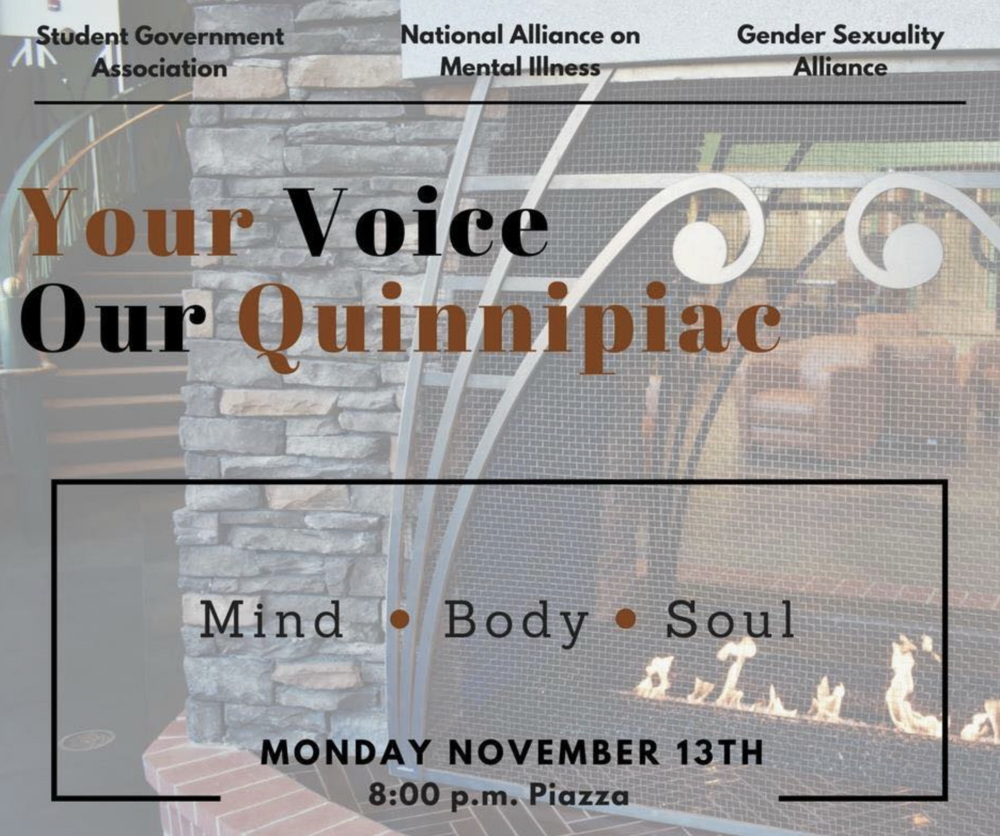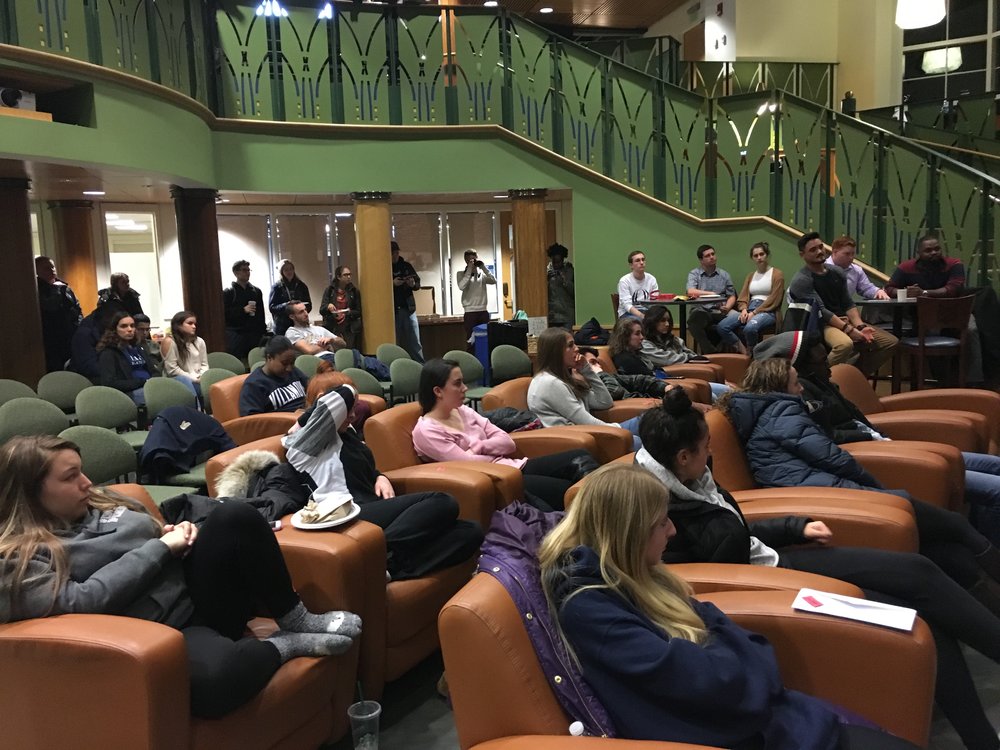As student demand for mental health services increases, Quinnipiac tries to keep up
By Dorah Labatte
At first, everything seemed fine. They were seeing each other consistently. It felt like things were really going somewhere and maybe someday he would be her boyfriend. The fall semester came to a close and the two said goodbye. She didn’t know it would be the last she would ever hear from him.
Spring semester began and she didn’t hear from him at all. He chose to no longer be a part of her life.
“Spring semester I was wildin’…I was going really hard. Partying really hard. It’s not ‘cause I was having fun, It was ‘cause I was sad,” Em said.
The sophomore college student at the time turned to alcohol and partying to treat her heartbreak. Instead of feeling better, she grew sadder over time. As a result, Em stopped going to class.
“I wasn’t talking to anyone. I was isolating myself and was sad that I was isolated … isolation from my roommates was the tipping point,” she said.
Em had a breakdown at her tipping point. Tears fell down her face and thoughts of guilt and shame filled her mind.
“I don’t remember the feeling of wanting to die then but I was really depressed,” she said.
Her roommates reported the incident to residential life. Soon after, Em began seeing a counselor at Quinnipiac’s health and wellness center.
“I think the counseling center was helpful in the fact that they were able to recognize that I needed help beyond what they could provide,” Em said. “If I went to the services alone I don’t think I would’ve been able to get that…being healthy again … from what I understand the counseling center is for short term problems.”
Quinnipiac University offers counseling services to students who experience any major changes in behavior and would like to seek treatment. But as the student population grows, the counseling center finds itself struggling to meet the demand.
As of November 3, with several weeks to go before the end of the semester, there were 596 new appointment requests from students. By contrast, at the end of fall semester in 2016, there were 570 new appointment requests. There has also been an increase in need for more frequent appointments. More students are requesting to be seen multiple times per week as opposed to weekly or bi-weekly.
In addition to university counseling services, students have established a group to provide peer support.
“Freshman year I failed out of the college I was going to and a lot of it was because of the depression I was experiencing,” said Ryan Freitas, vice president of Quinnipiac’s chapter of NAMI, the National Alliance of Mental Illness. NAMI estimates that 75 percent of mental health conditions begin by the age of 24.
Freitas, alongside NAMI President Peter Chlebogiannis, chartered NAMI on campus in January 2017 in hopes the club would act as a support group for students experiencing any mental illness.
“For me it’s really about creating an environment in a community … at least a place you can go where you at the very least know you’re not alone. I think the more people you have the better it becomes for everyone when people realize, you know, there are a lot of people, peers, going through the same stuff they are,” Freitas said.
NAMI’s advisor, Kerry Patton, has been the director of counseling services at Quinnipiac since 2013. Patton has experienced the change in issues facing students at Quinnipiac over the last four years.
“The top 3 that we see…and this is what students report, are anxiety, depression and relationship issues,” Patton said. Depression used to be the primary one and then anxiety was second. That has shifted a bit and I think a lot of it is related to mobile devices and social media. This generation isn’t as active interpersonally.”
Patton said students’ worry about Instagram likes or being liked in general could be the reason anxiety has become the No. 1 issue the office of counseling services deals with.
Social anxiety disorder is the fear of being judged and/or humiliated by others. According to the National Comorbidity Survey, a U.S. poll on mental health, social anxiety disorder is the third most prevalent psychiatric disorder in Americans, following depression and alcohol dependence. The National Institute of Mental Health (NIMH) reported a study conducted by Gabrieli Lab using brain imaging to show how the behavior of people with social anxiety disorder behavior changes based on their view of images of people versus scenic images. The study found that patients responded more to images of people’s faces.
Quinnipiac students who suffer from social anxiety disorder see many faces every day. Residential students in particular may rely on on-campus counseling services to seek help in treating their anxiety. With the increase of students requesting services over the last two years, Quinnipiac’s counseling services have been struggling to accommodate students that request services.
“We have seen about a 35 percent increase in students requesting to be seen by our counselors, over 500 students,” said Courtney McKenna, the director of student affairs at Quinnipiac University.
McKenna has worked at Quinnipiac since 2008. She started off in the Office of Campus Life then moved to the Office of Fraternity and Sorority life in 2014. In 2015, she started working in the Office of Student Affairs as a case manager, where she encountered many students who experienced a spectrum of mental illnesses.
Students who go to counseling do not fit a specific profile. However, a vast majority of students who request to see a counselor live on-campus and have a 3.0 grade point average or higher.
The International Association of Counseling Services, Inc.(IACS) recommends colleges/universities have a minimum of one full-time college counselor for every 1,500 students. For nine years, Quinnipiac employed five full-time counselors. The ratio at QU from 2008-2017 was one full-time college counselor to every 1,860 students. The increasing demand of students requesting counseling services has forced the university to take action.
Monique Drucker, Quinnipiac’s vice president and dean of students, is committed to making sure the university meets the minimum recommendation.
“At one point we had one counselor who had resigned from Quinnipiac to open her private practice and we weren’t able to replace that position for a year and half …” Drucker said. “That was a matter of budget and finance … so we were down to four counselors. Last year in the fall, we were able to hire another counselor.We had a wait list, which we don’t like to have.”
Other nearby universities, such as Wesleyan University and Fairfield University, have a fraction of students compared to Quinnipiac, yet have a bigger counseling staff. Wesleyan University (WU) has 3,206 students and seven professional counseling services staff members and six student externs. WU has one full-time counselor for every 712 students. On the other end, University of Hartford has 6,737 students and five professional counseling services staff members and five practicum students. University of Hartford has one full-time counselor to every 1,684 students.
“We were just approved to add a part-time counselor which gets us closer … We’re still falling a bit short of our goal,” Drucker said.
As of November 13, Quinnipiac’s counseling services had one full-time counselor for every 1,691 students. In order to meet the minimum recommendations set by IACS, Quinnipiac must hire one more full-time counselor.
Budget and finance has been a hurdle for meeting student affairs’ goal. Drucker’s emergency proposal justified the immediate need for an additional counselor. As a result, counseling services welcomed a part-time hire. Hiring an additional full-time counselor must be done during the budget and personnel approval process next year.
“We have therapists who can do outreach, who can do group therapy … but the fact is, they are every hour on the hour booked with students,” Drucker said. “I don’t have staff in that area to be able to utilize their knowledge, licensing and skill set to do the programming I’d want them to.”
Upcoming plans
Drucker, Patton and Mckenna have been working alongside Mark Thompson, executive vice president and provost, to design a plan that meets the needs of students in regards to counseling services.
“I think when we’re always putting out fires and just dealing with the thing that’s right in front of us we can’t step back to figure out what other things we could put in place to prevent things,” McKenna said.
McKenna believes the university should work toward providing more preventative education. She added that the school has outgrown the current health and wellness center and it is time for a new building.
“There are no current plans to renovate it or expand it but it is something we need to look at,” Thompson said.
Although Quinnipiac administration has not made any official plans to build a new space for a health and wellness center, they are working on adding more resources to counseling services.
“I don’t think the school ignores the prevalence of mental illness,” Em said.
Em said although counseling services did not work well for her during her sophomore year, she felt supported in her time of need.
###

